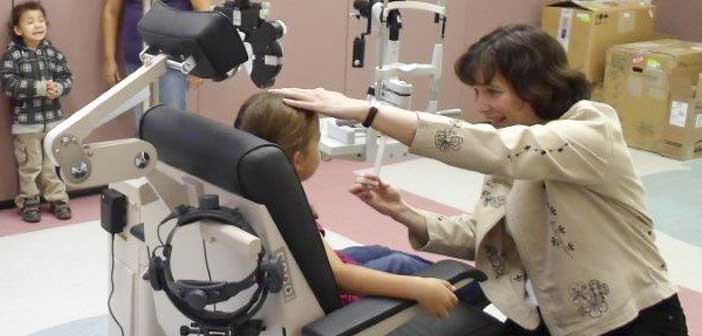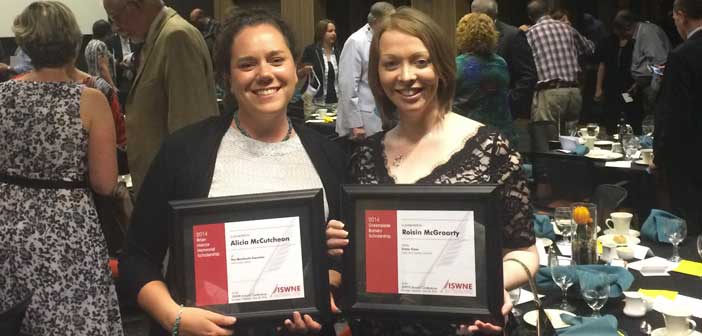M’CHIGEENG—It’s hard to be at the front of the class if you can’t even see that far. Experts all agree that vision plays a crucial role in the learning process, especially in this, the digital age, but only one out of six students have an eye exam before starting school. A team of vision care professionals from the Canadian Vision Institute is coming to Manitoulin Island this fall to conduct the M’Chigeeng First Nation (Lakeview) Elementary School Vision Care Project.
For two weeks, starting Monday, September 22, the team will conduct eye examinations on 40 daycare and 145 elementary school students. Each child who needs glasses will receive two pairs, courtesy of sponsor Essilor Canada—one of the largest lens manufacturers in the nation.
“Vision is so important to educational success,” noted Vision Institute of Canada Executive Director Paul Chris O.D. as he explained how the program works and why his organization undertakes these programs. Personally, Dr. Chris has another incentive for coming to Manitoulin. “I visited Manitoulin with my wife in the summer of 1989 and brought my wife to the Wiky Powwow. I found myself so attracted to aboriginal culture that I wanted to help play a part.” Dr. Chris said that he also “wanted to give back to the community.”
“The importance of comprehensive eye exams for school-age children is vital to learning. Eighty percent of what we learn comes through our sense of sight,” said Dr. Chris. “It has been reported in educational studies that First Nations children are visual learners. If sight is impaired and can be easily corrected with a pair of glasses, or if amblyopia and strabismus are detected and treated early, learning and quality of life can be dramatically improved.”
“Children spend the first few years in school learning to read,” he said. “But by Grade 4, they are ready to learn. If they can’t see to read properly, it delays their capacity to learn.”
Dr. Chris said that the issue of undetected vision problems is definitely not relegated simply to First Nations communities and schools. The issue is endemic throughout all of the education system. There is a story from one of the institute’s visits to a school in Toronto.
“There was a young girl in Grade 4 who we found with plus-eight (deficiency in sight). To give you some idea of what that means, a typical set of adult reading glasses that you or I might need would be around +2.50,” he said. “That is just for distance. Her mother was principal of the school and the young student had never had an eye exam.”
“Not only parents need to be educated on the need for early eye exams, but teachers and administrators need to understand how important proper vision care is to learning,” he said.
The truly distressing element in this story is that, for children under the age of 19, OHIP covers the exam—there is really no reason to not have a child’s eyes examined prior to them starting school.
Children cannot be expected to report that they are having difficulty seeing. “A child won’t tell you that they are having difficulty seeing out of one eye, they have nothing to relate it to,” said Dr. Chris. “For the child, that is how they think everyone sees.”
“Over the years we have expanded our charitable clinical services and our educational workshops and conferences,” said Dr. Chris of the Vision Institute of Canada, noting “we are actively involved in many programs designed to educate the public, government and other health care professionals about optometry and the importance of regular comprehensive eye examinations. The Vision Institute is also represented on the Eye Health Council of Ontario as an academic voice in support of quality eye health services and to enhance collaboration between optometry and ophthalmology.”
Dr. Chris noted that three years ago the Vision Institute declared 2011 Aboriginal Vision Health Awareness Year to raise awareness about the need for comprehensive eye examinations for First Nations people living with diabetes and for school-age children. “The high rates of diabetes facing First Nations people increase the risk of preventable vision loss which is a consequence of this chronic disease,” he said. “Yearly comprehensive eye exams can aid in the early detection and treatment of diabetic retinopathy and other complications such as glaucoma and cataracts.”
Dr. Chris noted that the Vision Institute has been well supported by its corporate sponsors. Thanks to its sponsors, Vision Institute is able to provide the necessary equipment and organize the moving of equipment in and out of the school; provide optometrists and opticians for the clinic according to an agreed-upon schedule of clinic days; secure resources to offer free eyewear to all students who require corrective lenses; dispense glasses in the school clinic when they are ready; and ensure the optometrists and opticians are credentialed and abide by the standards of their profession.
“I tallied up the equipment costs for our recent trip to Sagamok First Nation,” he said. “We had over $50,000 in equipment for that trip alone.” He explained that Innova Medical, Canada’s largest distributor of optithalmic equipment, loans the Vision Care program the equipment they need for the two-week program. We have a little bit of cost for transportation, but the equipment load really takes a big load off of the program. They really go all out for us, even supplying us with littlest of things we need.”





